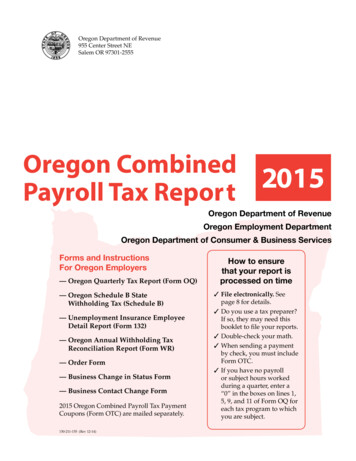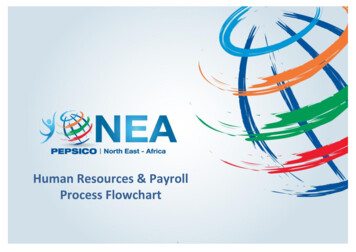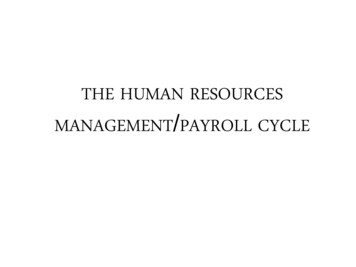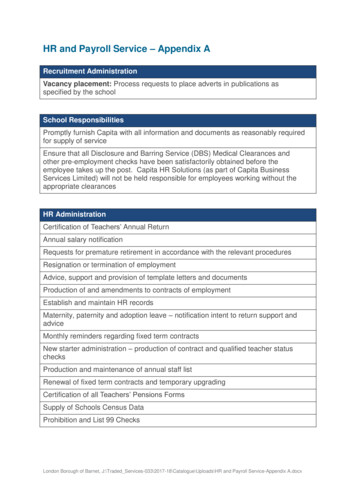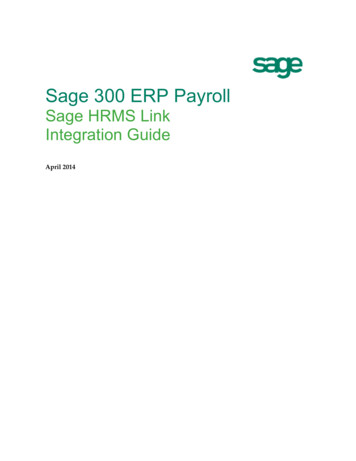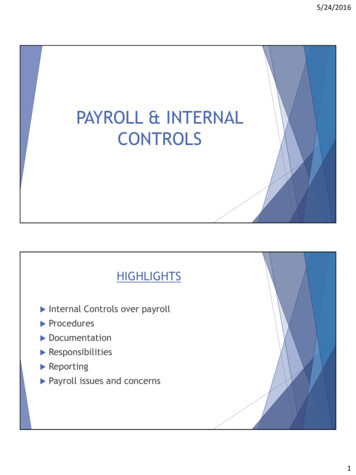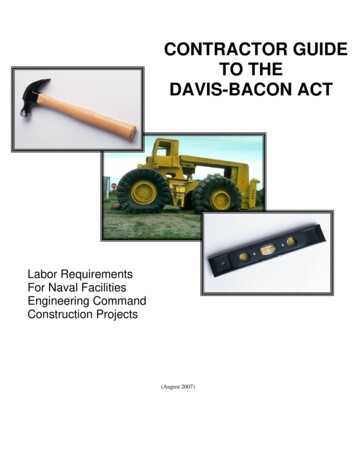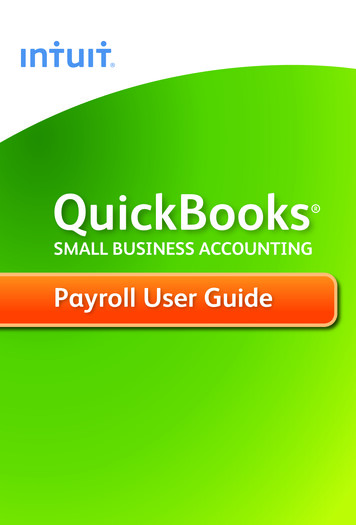
Transcription
Oregon Department of Revenue955 Center Street NESalem OR 97301-2555Oregon Combined2017Payroll Tax ReportOregon Department of RevenueOregon Employment DepartmentOregon Department of Consumer & Business ServicesForms and instructionsfor Oregon employers— Oregon Annual Withholding TaxReconciliation Report (Form OR‑WR)— Order Form— Business Change in Status Form— Business Contact Change Form2017 Oregon Combined Payroll Tax PaymentCoupons (Form OR‑OTC ) are not in this book‑let. They are mailed separately.150-211-155-2 (Rev 12-16)How to ensurethat your report isprocessed on time File electronically. Seepage 8 for details. Do you use a tax preparer?If so, they may need thisbooklet to file your reports. Double-check your math. When sending a paymentby check, you must includeForm OR-OTC. If you have no payrollor subject hours workedduring a quarter, enter a“0” in the boxes on lines 1,5, 9, and 11 of Form OQ foreach tax program to whichyou are subject.
Contact InformationState withholding, TriMet, LTD taxesWorkers’ Benefit Fund (WBF) assessmentOregon Department of Revenue (DOR)Salem:503-945-8100 or 1-800-356-4222TTY users: 503-945-8617 or 1-800-886-7204Fax:503-945-8772Email: payroll.help.dor@oregon.govMail:Oregon Department of Revenue955 Center Street NESalem OR 97301-2555Internet: www.oregon.gov/dor/bus Sign up for “Payroll Tax News” Payroll tax basics Oregon transit payroll taxes foremployers, including transit rates Withholding tables & formulaOregon Department of Consumer & BusinessServices (DCBS)Assessment questions:Salem:503-378-2372Fax:503-378-3134Email: wbfassess.fabs@oregon.govMail:WC Assessments UnitDCBS/CSD/Financial ServicesPO Box 14480Salem OR 97309-0405 www.oregon.gov/dcbs/pages/wbf.aspxInternet: What is the Workers’ Benefit Fund? Determining WBF hours worked Calculating the WBF assessmentTriMet BoundariesPhone:TriMet, 503-962-6466 orDOR, 503-945-8100Internet: www.trimet.org/taxinfoSubjectivity questions:Salem:503-947-7815 or 1-888-877-5670Email: wcd.employerinfo@oregon.govLane Transit District (LTD) BoundariesPhone:LTD, 541-682-6100 orDOR, 503-945-8100Internet: Reporting forms:Oregon Quarterly Tax Report (Form OQ)Business Change in Status FormBusiness Contact Change FormReporting forms:Oregon Quarterly Tax Report (Form OQ)Oregon Schedule B State Withholding Tax(Schedule B)Employee Detail Report (Form 132)Oregon Annual Withholding Tax ReconciliationReport (Form OR‑WR)Business Change in Status FormBusiness Contact Change FormState Unemployment Insurance taxOregon Employment Department (OED)Salem:503-947-1488TTY users: 711Fax:503-947-1700OTTER:503-947-1544Email: oed taxinfo user@oregon.govMail:Tax SectionEmployment Department875 Union St NESalem OR 97311-0030Internet: w ww.oregon.gov/employ/businesses/tax Electronic reporting Order or download forms UI account informationPayments for all tax programsOrder Form OR-OTCs:Salem:503-945-8100 or 503-378-4988Internet: w ww.oregon.gov/employ/businesses/taxOregon Combined Payroll Tax Payment Coupons(Form OR-OTC) are mailed separately to employ‑ers. You must include one with each payment.You don’t need to send Form OR-OTC if you useRevenue Online.Revenue Online (ROL)Internet: www.oregon.gov/dorEFT is being replaced by ROL. ROL providesconvenient, secure access to tools for paying andmanaging your tax account.Reporting forms:Oregon Quarterly Tax Report (Form OQ)Employee Detail Report (Form 132)Order form (paper report forms)Business Change in Status FormBusiness Contact Change FormPage 2
Employer new hire reporting programOnline resourcesOregon Department of JusticeSalem:Fax:503-378-2868 or 1-866-907-2857503-378-2863 or 503-378-28641-877-877-7415 or 1-877-877-7416Email: emplnewhire.help@doj.state.or.usMail:Department of JusticeDivision of Child SupportEmployer New Hire ReportingProgram4600 25th Ave NE, Suite 180Salem OR 97301Internet: www.oregonchildsupport.govOregon Employer Services Portal: employerportal.oregonchildsupport.govAll Oregon employers must report new andrehired employees to the Oregon Department ofJustice’s Division of Child Support no later than20 days from their hire date. www.wcd.oregon.gov Do I need Workers’ Compensation (WC)insurance? Employer incentives to hire an injured worker Insurers authorized to write Oregon WC policies sos.oregon.gov/business Starting a Business Employer’s Guide for Doing Business in Oregon Electronic Business Registration forms Electronic Business Update Registration forms www.irs.gov/businesses Contracting payroll service Acquiring a Federal Employer IdentificationNumber (FEIN) Federal payroll tax forms www.oregon.gov/boli Technical assistance for employers www.oregon.gov/boli/whd Minimum wage OvertimeTable of ContentsContact Information 2Tips for Successful Reporting 3Filing Due Dates for Quarterly Reports; Where to File and Pay 4New Information; Important Information 5Required Forms; Amended Forms; Other Forms 7Filing the Combined Quarterly Tax Report 8Payment Instructions 9Guidelines for Oregon Withholding Payment Due Dates; Penalties 10Interest; Credits 11Oregon Quarterly Tax Report (Form OQ) Instructions 12Employee Detail Report (Form 132) Instructions 15Oregon Schedule B State Withholding Instructions 15Unemployment Insurance Tax Information 16Withholding Tax Information 17Transit District Excise Tax Information 18Workers’ Benefit Fund Assessment Information 20Tips for Successful ReportingWhen you report all required information correctly, you can avoid delays in the processing of your forms.Delays may result in penalties, interest charges, and other fees you may be required to pay if you don’treport accurately and on time. If you use a payroll service, remember you are ultimately responsible forproviding accurate and timely reporting and payments.How to avoid common problems Use the correct Oregon Business IdentificationNumber (BIN). Put the BIN and quarter/year on each report formin the appropriate box. Use the correct tax and assessment rates. If using non-prefilled forms, make sure to includename and address. Keep copies of Form OQ, Schedule B, Form 132,and Form OR‑OTC for your records. Report whole hours on Form OQ (WBF assess‑ment) and on Form 132. Reduce calculation errors and other mistakesby filing your report electronically. See FilingOptions on page 8.Page 3
Filing Due Dates for Quarterly ReportsQuarterQuarter Ending DateReport Due Date1st — Jan–Feb–MarMarch 31, 2017April 30, 20172nd — Apr–May–JunJune 30, 2017July 31, 20173rd — Jul–Aug–SepSeptember 30, 2017October 31, 20174th — Oct–Nov–DecDecember 31, 2017January 31, 2018If the due date is on a weekend or holiday, the report is due the next business day.Where to File and PayAll reports usingEmployment DepartmentsoftwareSend electronically(see page 8)All quarterly wages andannual W-2s usingelectronic filing(EFW2 format)Send electronically(see page 8)All reports inpaper formMail to:Oregon Department of RevenuePO Box 14800Salem OR 97309-0920(see pages 7)All paymentsForm OR‑OTC(see page 9)Mail Form OR‑WR with payment to:Form OR‑WRAnnual Withholding TaxReconciliation ReportOregon Department of RevenuePO Box 14800Salem OR 97309-0920(see page 7)Mail only Form OR‑WR to:Oregon Department of RevenuePO Box 14260Salem OR 97309-5060In compliance with the Americans with Disabilities Act (ADA), this information is available inalternative formats by calling the Oregon Department of Revenue, 503-378-4988, or 1-800-356-4222(toll free from an Oregon prefix) or the Oregon Employment Department, 503-947-1488.Page 4
New InformationTax rates The Workers’ Benefit Fund (WBF) assessment rateis 0.028. The taxable wage base for UnemploymentInsurance (UI) is 38,400. Tri-County Metropolitan Transportation District(TriMet) tax rate is 0.007437. Lane Transit District (LTD) tax rate is 0.0072.Required reportingOn Form 132, there's a new column to be used byemployers subject to UI. The new column six is toreport Oregon withholding tax.Nonresident employees with Oregon wages lessthan their standard deduction still may ask youto withhold tax. Usually, this is because they haveadditional Oregon income from other sources.Oregon Retirement Savings PlanStarting in mid-2017, the Oregon Retirement Sav‑ings Plan will offer a savings option for people lack‑ing one through their employer. The plan will besimple and let workers save part of their pay intotheir own professionally-managed accounts. Theplan will benefit small employers, who won’t needto establish a company retirement program. Formore information, go to www.oregon.gov/retire.Employers of Oregon nonresidentsRevenue Online (ROL)You must withhold Oregon income tax from allwages earned by nonresident employees for theirservices performed in Oregon, unless their Oregonearnings for the year will be less than the standarddeduction amount for their filing status. The Oregonstandard deduction amounts for tax year 2017 are:ROL, our new self-service site, is now available forcombined payroll taxpayers. ROL provides conve‑nient, secure access to tools for managing your taxaccount—and it’s free! With ROL, you can:Single, married or RDP* filing separately. 2,175Head of household. 3,500Married/RDP filing jointly. 4,350Qualifying widow(er). 4,305*Registered Domestic Partner View your tax account. Make payments. View and print letters from us. Send us secure messages. Check your account balance and more!For more information or to sign up for an account,go to www.oregon.gov/dor.Nonresident employees with wages more thantheir standard deduction amount must file anOregon nonresident income tax return.Note: The W-2 filing date has changed toJanuary 31 of each year. 1099s with information inbox 7 will be due January 31.Important InformationOregon Department of Revenue (DOR), OregonEmployment Department (OED), and Departmentof Consumer and Business Services (DCBS) rulesmay be different from each other. Read all instructions carefully. If you have questions, contact theappropriate agency (see page 2).Oregon identification numbersWhat is a filed return?The correct format for a BIN is NNNNNNN-N (forexample, 1234567-8).Only columns on Form OQ that are filled in withnumerical information are considered a filed return(for example, using a 0 rather than a blank space).You don’t need to file Form 132 or Schedule B if youfile a non-payroll report.Your Oregon Business Identification Number (BIN)is not the same as your registry number issued bythe Oregon Secretary of State’s Corporation Divi‑sion. If you don’t know your BIN, contact DOR(see page 2).You must include your BIN at the top of all cor‑respondence, returns, and payments that you filewith DOR, OED, and DCBS.Important: If the structure of your business haschanged, contact DOR (see page 2).Page 5
Withholding tax tables and formulasThe Oregon withholding tax tables and formulaswill be updated each year by December 1, with aneffective date of January 1. DOR will send informa‑tion through the Payroll Tax News. Contact DORfor more information (see page 2).Small employers and withholdingSmall employers must file quarterly with DORusing Form OQ, unless they qualify for annualreporting as an agricultural or domestic householdemployer under Oregon law. Contact DOR formore information (see page 2).Sole corporate officer UI exclusionEffective January 1, 2016, if you’re a sole corporateofficer who is also a corporate director and owns asubstantial part of your corporation, you may electout of UI coverage for yourself. You must apply toOED in writing and OED must approve the exclu‑sion prior to it going into effect [ORS 657.044 (1)(b)].W-2 informational returnsAll businesses and payroll service providers mustreport W-2 information electronically to DOR usingiWire (see page 8). The filing due date is January 31of each year.1099 electronic filing requirementsIf your business reports Forms 1099-MISC, 1099-G,1099-R, or W-2G, you must submit them electroni‑cally by March 31 of each year. 1099s with informa‑tion in box 7 will be due January 31.You’re required to file electronically if you have 10or more information returns. An information returnis a tax document you must file to report certainbusiness transactions to DOR and the IRS, such as1099s. (ORS 314.360)Penalties assessedHouse Bill (HB) 2464 allows DOR to assess pen‑alties for employers who do not file a timelyinformation return (Form W2 or 1099) or file anincorrect or incomplete information return. DORmay assess 50 per information return, up to anannual maximum amount of 2,500. DOR mayraise the penalty to 250 per information return,up to an annual maximum amount of 25,000,for employers who knowingly fail to file a timelyinformation return or knowingly file an incom‑plete, false or misleading information return.Unemployment Insurance—Alternate baseyearIndividuals that file a claim for UnemploymentInsurance benefits might qualify using an AlternateBase Year. To determine if they qualify, OED willsend a request for information to the last knownemployer. The response to this notice doesn’treplace Form OQ. You need to include the wagesand hours for all subject employees, whetherusing a Regular or Alternate Base Year on yourForms OQ and 132. Contact OED for more infor‑mation (see page 2).Independent contractorsTo be an independent contractor, workers mustmeet the statutory definition in ORS 670.600. Thislaw covers DOR, OED, Construction ContractorsBoard, and Landscape Contractors Board.The laws covering the WC Division of DCBS andthe Bureau of Labor and Industries (BOLI) differfrom ORS 670.600.Misclassifying employees as independent con‑tractors can be costly to an employer. For moreinformation about independent contractors, visit www.oregon.gov/ic.BankruptcyIf you file for bankruptcy, you need to notifyseparately each state agency that administers thepayroll taxes or assessments to which you aresubject.Common pay agentOregon law doesn’t allow Oregon combined pay‑roll taxes to be reported by a “common pay agent”as defined in IRS Section 3504.Keep your recordsYou must keep WBF assessment-related payrollrecords for at least four years.You must keep all other payroll records for at leastsix years after filing the required reports.Page 6
Required FormsIf you file paper forms, using the forms in this book‑let ensures faster and more accurate processing.We process paper forms electronically. It’s criticalfor successful reporting to use the correct formatand color of ink.To avoid problems: Use only blue or black ink. Use only original forms. Don’t photocopy or faxyour reports. Use CAPITAL LETTERS ONLY when filling outyour reports.If you use a tax preparer, check with them to seeif they need this booklet to file your reports. Yourforms can be sent directly to your tax preparer.Fill out the Business Contact Change Form to changethe mailing address to your tax preparer’s address.Use the order form at the back of this booklet toorder more reporting forms.Forms needed for reportingForm 132—Use only if you are reporting UI sub‑ject wages. Form 132 is filed with Form OQ on aquarterly basis.You must include:1. Total UI subject wagesDetailed information for each employee:2. Social Security number3. First initial4. Last name5. Whole hours worked6. Total UI subject wages7. State withholding taxesForm OR‑OTC—File with each payroll tax pay‑ment to show how the amount paid is to be distrib‑uted among withholding tax, UI tax, TriMet andLane Transit District taxes, and WBF assessment.Amended formsUse fillable amended report forms available atOEDs website (see page 2):Form OQ—File this form each quarter to documenthow you calculate the amounts of withholding tax,UI tax, TriMet and Lane Transit District taxes, andWBF assessment you owe. Form OQ/OA–AMENDEDAlso use it to report withholding on pension/annu‑ity payments.DOR: You may make changes as far back as nec‑essary to make corrections and report the properamount of withholding and transit taxes. However,if that correction results in a refund, you have threeyears from the due date of the return, or two yearsfrom the date the tax was paid, whichever is later,to request that refund.Schedule B—For withholding tax only. Use thisform only if you must make semi-weekly or dailystate income tax withholding deposits. File Sched‑ule B with Form OQ to document withholding taxdeposit amounts by deposit date.NOTE:Form OQ, Schedule B, andForm 132 are processed byOED using automated equipment. Form OR-OTC andpayments are processed byDOR. To correctly apply payments, send a Form OR-OTCwith every payment, including payments made with yourForm OQ. Form OR-OTC isnot required for paymentsmade by EFT. Schedule B–AMENDED Form 132–AMENDEDOED: You may make changes to the UI tax portionof the reports for any quarter between the firstquarter three years back and the current quarter.DCBS: You may make changes to the WBF assess‑ment portion of the reports for any quarter betweenthe first quarter three years back and the currentquarter.Other formsBecause we process reports and payments elec‑tronically, our systems won’t pick up specialinstructions or notations you write on Form OQ orForm OR‑OTC. Use the following forms, located inthe back of this booklet, to make updates:Page 7
Business Change in Status Form—Use this form toupdate your business information, such as: chang‑ing a business name, correcting an FEIN, selling orclosing a business, no longer working in a transitdistrict, and starting a business in a transit district.If the structure of your business changes, you mayneed to complete a Combined Employers Registration.Business Contact Change Form—Use this formto update your contact information, such as:physical, mailing, or email address; phone or faxnumber; and off site payroll service, accountant,or bookkeeper.Form OR‑WR—Required by all employers whowithhold state income tax from their employees.It is filed annually by employers to reconcile theOregon state withholding taxes reported to DORwith all Oregon W-2s and 1099s issued to youremployees. If you stop doing business or no longerhave employees, Form OR‑WR is due 30 days afteryour final payroll.Filing the Combined Quarterly Tax ReportWho must filefor updates on electronic filing options at: www.oregon.gov/employ/businesses/tax.You must file a Form OQ each quarter if you: Are registered as an active employer with DORor OED, even if you had no payroll during thequarter. Reimbursing employers and Local Gov‑ernment Employers Benefit Trust Fund employersalso must file Form OQ. Have paid workers subject to Oregon’s WC law,or any paid individuals covered by WC insurance,whether or not required by law. Withhold on a distribution of pensions orannuities.You must file Schedule B if you: Are required to deposit withholding taxes on asemi-weekly or a one-banking-day basis.You must file Form 132 if you: Are an employer subject to UI law, Are a reimbursing employer, or Are a Local Government Employers Benefit TrustFund employer.When to fileSee page 4 for report due dates.Failure to fileIf you don’t file a correct, complete report, you mayreceive an assessment from each agency based onavailable information. Each agency may chargepenalties and interest on the amount assessed (seepages 10-11).Filing optionsInstead of filing by paper, consider filing elec‑tronically. Electronic filing is more efficient,accurate and takes less time than paper. Check Telephone (IVR). If you are an employer whohas no payroll or subject hours to report for allprograms for a particular quarter, you can file a“no-payroll/no-hours worked” report by tele‑phone. IVR is available 24 hours a day, seven daysa week. Call 503-378-3981. Confirmation numbersaren’t issued. Stay on the line until you’re noti‑fied at the end of the call that your report wasaccepted. Electronic wages only. Using the federal EFW2format, larger employers can upload UI wages toa secure site. You’ll need to file a paper Form OQand Schedule B.Oregon annual filing iWire—Income and Wage Information ReturnE-services. File Form W-2s electronically to DORusing the EFW2 format provided by the SocialSecurity Administration. File Forms 1099-MISC,1099-G, 1099-R, and W-2G electronically forOregon purposes using the same file specifica‑tions used by the IRS. For more information, goto the IRS website (Publication 1220) (see page 3). If you file federal Form 943, you may file yourOregon withholding reports once a year usingForm WA. Agricultural employers subject to UItax, WBF assessment, or transit tax must file FormOQ in addition to Form WA. Contact DOR formore information (see page 2). Domestic household employers with employeesdoing only in-home services may file the com‑bined payroll tax reports annually using Form OADomestic. The forms are sent by November 15 ofeach year. Contact OED for more information (seepage 2).Page 8
Payment Instructions Check your account balance and more!For more information or to sign up for an account,go to www.oregon.gov/dor.To make sure your payment is correctly applied: Complete and send in Form OR‑OTC with everypayment when due, including payments madewith your Form OQ. Show the amount paid to each tax program inthe appropriate boxes on Form OR‑OTC. Don’tinclude credits (see page 11). Enter the quarter for which you are makingpayment. If amending your reports, include Form OR‑OTCwith payment. If paying more than one quarter, use a separatecoupon for each quarter. Use current-year personalized coupons. Changesto the coupons or using the wrong coupon couldresult in misapplied payments. Payments for UI tax, WBF assessment, and transittaxes are due when reports are due. Payments for withholding tax are based on federaldeposit schedule (see page 10). Don’t staple or tape check to Form OR‑OTC. Make checks payable to Oregon Department ofRevenue. Send Form OR‑OTC and your check to:Oregon Department of RevenuePO Box 14800Salem OR 97309-0920 Keep all payment records (see page 6).Alternate withholding methodMulti-state employers with small payrolls inOregon must deposit following the same sched‑ule as the federal deposit schedule. Multi-stateemployers who find that following the federal taxdeposit schedule will cause a burden may requesta different method of withholding tax payments.To do this, send a letter that includes your businessname, BIN, nature of the burden, your proposedwithholding method, and proposed effective dateof modified withholding method.Send this information to:Withholding ManagerDepartment of Revenue955 Center Street NESalem OR 97301-2555Continue using the federal requirements until DORapproves your request and designates the changedate (ORS 316.191).Federal Form 944 filersRevenue Online (ROL)As an employer, Oregon law requires you to file taxreturns quarterly with DOR. You’re also required topay taxes using federal deposit schedules. If you’rean employer instructed by the IRS to file Form 944and deposit annually, please continue to deposityour Oregon withholding tax payment quarterly.ROL is now available. ROL provides convenient,secure access to tools for managing your taxaccount—and it’s free! With ROL, you can:View your tax account.Make payments.View and print letters from us.Send us secure messages.Date ReceivedOREGON COMBINED PAYROLL TAXOR-OTCPayment Coupon150-211-053 (Rev. 9-16)YEAR Enter quarter payroll was paidto employees: (1, 2, 3, or 4) Lane Transit District ExciseSAMDTOTAL PAYMENT (add all the boxes at left)Workers’ Benefit Fund AssessmentPLEPage 9BUSINESS ID NO.Make check payable to:Oregon Department of RevenuePO Box 14800Salem OR 97309-0920O NOTUSE TriMet District Excise State WithholdingForm State Unemployment You will receive a penalty if you file your Oregonreturn quarterly and deposit your withholding taxpayment annually, unless you tell us that you payannually for the IRS. To avoid penalty, send us acopy of your IRS notification before your first DORpayment is due. Contact DOR for more informationon small employers (see page 2).
Guidelines for Oregon Withholding Payment Due DatesOregon withholding tax due dates are the same as the dates for depositing federal tax liability.New employers must deposit monthly until they have a lookback period* established.If your total FEDERALtax liability is:Oregon withholdingtax payments are due: Less than 2,500for the quarterBy the quarterly report due dateExample: If your federal tax liability is 2,300 and your state income tax liability is 1,500, youdeposit quarterly. 50,000 or less inthe lookback period*By the 15th of the month following payrollExample: If your federal tax liability is 5,000 and your state income tax liability is 2,500, youdeposit monthly. More than 50,000 inthe lookback period*Semi-weekly deposit scheduleIf the day falls on a:Then pay taxes by:Wednesday, Thursday,The next Wednesdayor FridaySaturday, Sunday,The next FridayMonday, or TuesdayExample: If your federal tax liability is 60,000 and your state income tax liability is 25,000, youdeposit semi-weekly. 100,000 in asingle pay periodWithin one banking dayExample: If your federal tax liability is 120,000 and your state income tax liability is 75,000, youdeposit the next business day.Payrollspaid in:Quarter 1JanuaryFebruaryMarchQuarter 2AprilMayJuneQuarter 3JulyAugustSeptemberQuarter 4OctoberNovemberDecember* The lookback period is the12-month period that endedthe previous June 30. Thelookback period for agricultural employers is the calendar year before the calendaryear that just ended.PenaltiesUnemployment Insurance (UI) taxA late-filing penalty may be assessed if you fileForm OQ or Form 132 more than 10 calendardays after the due date and received a warningor had a penalty assessed within the past 3 years.Incomplete or incorrectly formatted forms may bereturned to you. You must resubmit these forms bythe 10th day after the due date to avoid a penalty.The UI tax late-filing penalty is 7 for eachemployee reported, with a 100 minimum and 1,800 maximum penalty. If no subject wages arereportable, but you file the report late, you may beassessed a penalty up to 100.OED may assess a penalty if you fail to pay a taxassessment. The penalty will be 10 percent of theunpaid tax for that assessment.OED may assess a 50 percent penalty of the unpaidtax balance if the agency finds out that an employeris intentionally avoiding paying UI tax. [ORS657.515(5)]OED may charge an employer an additional 1 percentpenalty if, as of September 1, the employer hasn’t: Filed all UI tax reports:—Form OQ, or—Form 132, or Paid all UI taxes due.The penalty is 1 percent of the employer’s previousyear’s taxable payroll.Note: These penalties are in addition to interest.Under OED law, an employer may not engage inor advise another employer to engage in activity totransfer or acquire, or attempt to transfer or acquire,Page 10
a trade or business or any part of a trade or busi‑ness solely or primarily for the purpose of gettinga lower UI tax rate.penalty of up to 10,000. Criminal penalties forengaging in tax avoidance schemes also may beIf an employer knowingly engages in such activity,the highest UI tax rate (currently 5.4 percent) willbe assigned to that trade or business for the tax yearin which the activity occurred and for the next threeyears. However, if the employer is already subjectto the highest tax rate for the year, or if the amountof increase in the tax rate is less than 2 percent,an additional penalty tax rate of 2 percent will beadded to the calculated tax rate.State withholding and transit taxesAlso, if any person advises an employer to engagein this activity, the adviser may be charged a civilimposed. DOR charges a 5 percent late-payment penaltyon any unpaid tax after the return’s (Form OQ)due date. DOR charges an additional 20 percent penalty onany tax due as of the due date if you file Form OQmore than one month late. DOR may charge a 100 percent penalty on anytax due if you don’t file Form OQ for 12 quartersin a row.InterestUnemployment Insurance (UI) taxState withholding and transit taxesGeneral employers. OED assesses interest on unpaidor late UI tax. The rate is 1.5 percent per month orfraction of a month after the payment is due.DOR charges interest on any rema
If you have no payroll or subject hours worked during a quarter, enter a 0 in the boxes on lines 1, 5, 9, and 11 of Form OQ for each tax program to which you are subject. 2017 Oregon Department of Revenue Oregon Employment Department Oregon Department of Consumer & Business Services Forms and instructions for Oregon employers
